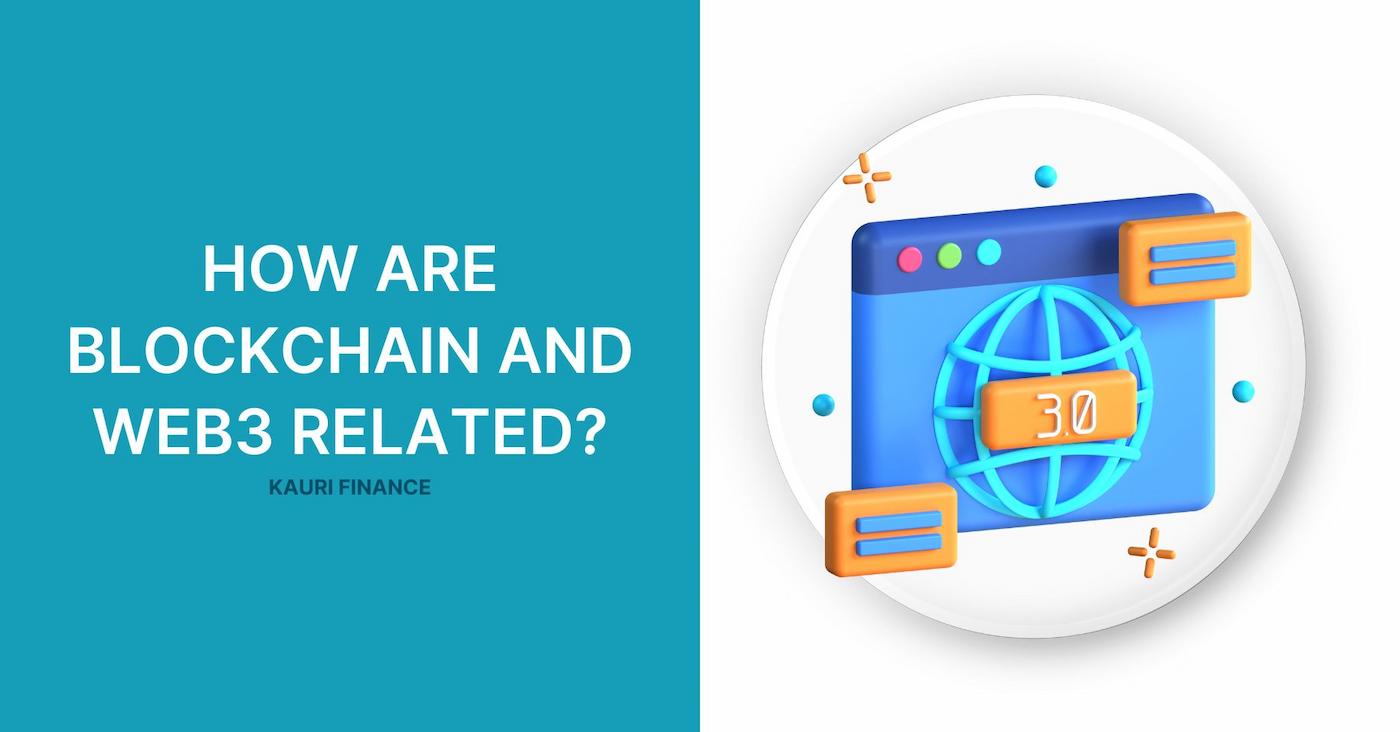
How are Blockchain and Web3 Related?
- What is Web3?
- Blockchain's Role in Web3
- Blockchain's Role in Web3
- Decentralization
- Improved Security
- Decentralized Autonomous Organizations (DAOs)
- Impact of Digital Assets on Web3
- Cryptocurrencies and Native Digital Payments
- Tokens as Functional Tools
- Integration into Digital Economies
- Key Features of Web3
- Blockchain and Crypto in Web3 Infrastructure
- New Technologies Complementing Blockchain in Web3
- Conclusion

Often regarded as the third generation of the web, Web3 represents a significant evolution from our current internet, introducing concepts and technologies that aim to rectify the centralization and privacy concerns prevalent today. At the heart of this transformation is blockchain technology, which plays a pivotal role in decentralizing power away from traditional centralized entities and enabling permissionless access to digital interactions. This introductory article explores how blockchain is not just supporting, but actively shaping, the infrastructure of Web3, making it a truly user-centric platform.
What is Web3?
Web3 signifies a transformative leap from the static pages of Web1 and the user-generated content era of Web2, ushering in a fully interactive and autonomous internet. In Web1, user interaction was minimal, limited to reading static HTML pages. Web2 evolved this by allowing users to create content and interact on platforms that, unfortunately, grew to monopolize data and user interactions. This centralization led to concerns over privacy, data ownership, and the unchecked power of large corporations.
Web3 seeks to dismantle these monopolies by leveraging blockchain technology to facilitate a decentralized internet where users retain control over their data and interactions. This transition represents a move towards a more privacy-focused, user-empowered internet landscape, aiming to mitigate the issues of censorship and centralized control seen in Web2.
Blockchain's Role in Web3
Blockchain is foundational to the Web3 vision, providing a decentralized framework that ensures transparency and security across various applications. This technology allows for the creation of decentralized autonomous organizations (DAOs), which exemplify the shift towards a user-governed internet. DAOs operate without a central authority, giving power back to the users who can propose, vote on, and implement changes within the network.
Blockchain's immutable ledger ensures that all interactions are transparent and secure, preventing tampering and promoting trust among users. This decentralization not only enhances user privacy and security but also fosters a new level of user empowerment, where communities can collectively make decisions and manage resources without needing to trust a central authority.
Blockchain's Role in Web3
Blockchain technology is pivotal in enabling the decentralized architecture of Web3, moving away from the centralized models that dominate the current internet landscape. By providing a distributed ledger system, blockchain allows data to be stored across a network of computers, making it nearly impossible for the data to be controlled by any single entity. This decentralization is crucial for reducing the risks associated with data monopolies and enhancing user privacy and control over personal information.
Decentralization
Blockchain facilitates a level of transparency previously unattainable in digital interactions. Each transaction and its associated details are recorded on a blockchain, visible to anyone and immutable once confirmed. This transparency helps build trust among users, as activities can be audited by anyone, reducing the likelihood of fraudulent activities and corruption.
Improved Security
Security features of blockchain are derived from its decentralized nature and cryptographic algorithms. Each block in the chain is linked to the previous one via cryptographic hashes, creating a secure and unalterable chain of records. This makes the blockchain incredibly resistant to hacking and unauthorized alterations, providing a secure foundation for digital transactions and interactions.
Decentralized Autonomous Organizations (DAOs)
DAOs are blockchain's unique contribution to Web3. These organizations are subject to protocols encoded in the blockchain and are governed solely by the consensus of participants without the need for traditional governance structures. DAOs create a democratic and fair model in which every participant has a stake and a say in decision-making processes. This structure enables users to directly influence the development and operation of projects, ensuring that benefits and outcomes are aligned with the collective interests of the community rather than dictated by a few powerful stakeholders.
Impact of Digital Assets on Web3
Digital assets, including cryptocurrencies and various types of tokens, play a foundational role in the functionality and economy of Web3. These assets are not just mediums of exchange but also serve as integral components of digital economic systems, providing a wide range of utility beyond simple transactions.
Cryptocurrencies and Native Digital Payments
Cryptocurrencies are perhaps the most well-known form of digital assets within Web3. They facilitate native digital payments that are secure, immediate, and global, transcending traditional financial barriers and costly intermediaries. This capability is particularly crucial in Web3, as it supports the creation of a fully integrated and autonomous digital economy. Users can engage in transactions, investments, and even complex financial operations like staking or lending, all within a decentralized framework that operates independently of conventional financial institutions.
Tokens as Functional Tools
Beyond cryptocurrencies, Web3 utilizes various other tokens that are programmed to perform specific functions within digital economic systems. These tokens can represent anything from voting rights within a DAO to access rights in decentralized applications (dApps). For example, utility tokens can enable interactions and transactions within specific dApps, granting users access to certain functionalities or services. Governance tokens confer voting power, allowing token holders to participate in decision-making processes that dictate the direction and operation of a project.
Integration into Digital Economies
Digital assets are crucial for building robust economic systems in Web3. They enable the creation of incentive structures, reward mechanisms, and economic policies that are enforced by code, not by centralized authorities. This not only enhances efficiency but also ensures transparency and fairness in economic interactions. As programmable assets, tokens can be designed to support a wide range of economic activities, including but not limited to:
- Reward Systems: Tokens can be used to incentivize certain behaviors or achievements within a network, such as contributing content, providing liquidity, or participating in network governance.
- Access and Subscription Models: Some tokens function as keys that unlock access to specific services or content within Web3, similar to subscription fees in the traditional sense but operated in a decentralized manner.
- Ownership and Asset Management: NFTs are a type of digital asset that represent ownership of unique items or content, providing a secure and verifiable way to manage digital property rights.
Key Features of Web3
- Power Distribution: Blockchain technology fundamentally alters the way information and power are distributed, moving away from centralized entities to a more dispersed network of participants.
- Data Management: Unlike traditional models that centralize data storage, blockchain disperses data across its network, enhancing security and reducing single points of failure.
- Open Access: Blockchain enables a permissionless environment where anyone can participate without needing approval from a central authority, fostering innovation and inclusivity.
- Reduced Intermediary Reliance: Trustlessness means transactions and interactions occur based on verifiable code without the need for trusted intermediaries, streamlining processes and reducing potential biases or fraud.
- Promoting Free Expression: By design, blockchains are resistant to censorship, ensuring that once data is added to the blockchain, it cannot be easily altered or removed. This feature is crucial for preserving free speech and preventing undue interference by powerful entities.
Blockchain and Crypto in Web3 Infrastructure
- Digital Native Payments: Cryptocurrencies serve as the primary method of transaction within Web3, providing a seamless, borderless, and efficient means of exchanging value.
- NFTs for Identity and Ownership: Non-fungible tokens (NFTs) play a critical role in Web3 by enabling verifiable digital ownership and identity, essential for user interaction and transaction within digital spaces.
- DAOs for Decentralized Governance: Decentralized Autonomous Organizations (DAOs) offer a new model of community-centered governance, where decisions are made collectively by stakeholders rather than centralized authorities.
New Technologies Complementing Blockchain in Web3
Augmented Reality (AR) and Virtual Reality (VR):
- Enhanced Interactivity: AR and VR can significantly enrich user experiences in Web3, creating immersive environments that integrate digital information with the physical world.
- New Realms of Engagement: These technologies allow users to interact in ways that were previously impossible, offering new avenues for social interaction, entertainment, and education.
Internet of Things (IoT):
- Device Connectivity: IoT technology enables devices to communicate and interact with each other over the internet, creating smart environments that respond intelligently to user needs.
- Blockchain as a Backbone: Integrating IoT with blockchain can enhance security and data integrity, ensuring that device communications and transactions are immutable and verifiable.
Unified Digital World:
- Metaverse and Beyond: The convergence of AR, VR, IoT, and blockchain could lead to the creation of the metaverse, a fully immersive digital world where users can live, work, and play in a seamlessly interconnected environment.
- Token Utility Expansion: In such a world, cryptocurrencies and tokens could underpin not only financial transactions but also access rights, identity verification, and much more, establishing a comprehensive digital economy.
Conclusion
Blockchain technology is at the heart of the Web3 revolution, offering a transition to a decentralized internet that prioritizes user autonomy, security and direct interaction without intermediaries.
Kauri Finance is dedicated to the development of blockchain and the Web3 sector. Our wallet is designed for a wide range of Web3 interactions. Whether you trade digital assets, manage NFTs or participate in DAOs, Kauri Web3 Wallet offers a secure and convenient platform for all your Web3 needs. Learn more about how our wallet can enhance your digital experience in the evolving world of Web3.
